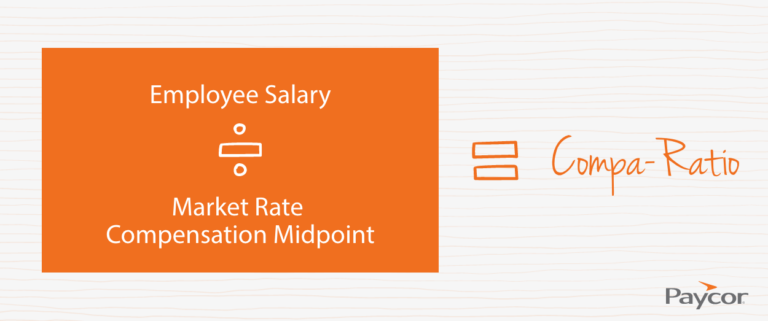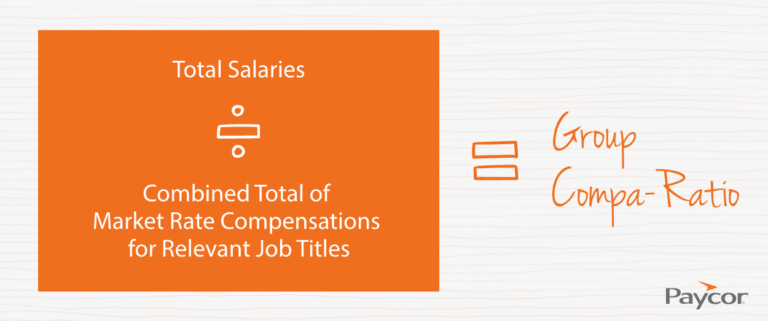In today’s competitive labor market, HR’s top priorities are attracting and retaining talent. To do that, you need a robust compensation strategy. Business leaders use some common resources to develop compensation strategies, like data from the Bureau of Labor Statistics, combined with a few simple formulas.
Comparison ratio – also called comparative ratio, or compa-ratio – is a key metric you can use in this process. Compa-ratio measures an employee’s actual salary against the median salary for their position or similar positions at other companies. This number reveals how far an employee’s pay is from the market midpoint (think “fair-market rate”). If an employee has a compa-ratio of 100%, their salary is right “at market.” But if their compa-ratio is in the 50th percentile, it’s pretty low by industry standards.
Compa-ratios help businesses decide if they’re properly compensating employees. When employee compensation is too low, you risk losing high-quality, long-term employees and attracting underqualified candidates. At the opposite end of the spectrum, if your company’s pay is too high, you could be mismanaging resources and negatively affecting the bottom line.
How to Design Your Compensation Strategy
Determining salary ranges plays a big part in compensation planning. First, take the time to properly define pay ranges (also known as pay grades or pay bands). That ensures you’re paying employees fairly, and it also helps with budget forecasting.
To get started, review all your job descriptions, and rank them by complexity and value to your company. Then, research prevailing salaries for those positions (Glassdoor is a good place to start). You’ll need to determine the low-end, midpoint, and top-range salary for each position. With salary bands in place, you can now establish your compa-ratios.
Check out this resource to learn more about establishing salary ranges.
How Does Compa-ratio Help Compensation Planning?
When onboarding a new hire, most businesses start them at the bottom of a salary range or a pre-determined percentage above it. These types of policies give companies some wiggle room to offer pay increases as the employee gains experience and tenure.
How to Calculate an Individual Compa-Ratios
Use this formula to calculate the compa-ratio for a particular job title or employee:

How to Calculate a Group Compa-Ratio
Calculating a group compa-ratio lets you measure the difference among salaries within a whole company or department. To find a group compa-ratio, use this formula:

This calculation can help you determine how effectively your pay policy is being implemented across the company. It can also highlight any disparities between departments. If you do find differences, it’s important to understand what’s driving them. Some common causes are:
- Location-specific pay for employees around the country
- Disparities in role responsibilities
- Tenure at the company
- Previous experience
But you could also uncover problems with your compensation practices. Unusually low or high compa-ratios could point to pay policy issues, like pay ranges that lag behind the market, or a need to update job titles and descriptions that have morphed over time. When you review compa-ratios, make sure you consider base salaries as well as any annual bonuses or other forms of compensation your company offers. The way you calculate performance ratings could also play a role here.
A group comparative ratio can also highlight differences between employee groups sorted by gender, ethnicity, age, and similar demographics. This is an important way for HR to assess the potential for conscious or unconscious bias among hiring managers and other decision-makers.
Group compa-ratios are an easy way to see whether your compensation strategy needs attention. However, that number alone won’t tell you exactly what’s wrong or how to fix it. Before you make sweeping changes, make sure you research the root cause of the problem.
Balancing Compa-Ratio with a Complete Benefits Package
Salary is a top reason people stay at or leave a job – but it’s not the only reason (World Economic Forum). Today’s workers also rank work-life balance, learning opportunities, and flexibility (of scheduling or location) as high priorities. Comparative ratio is an important factor in employee satisfaction and retention, but make sure to weigh it against the other benefits you offer. For example, a compa-ratio below 100% can sometimes be balanced out with top-notch health insurance, equity, or other compelling options.
Compa-Ratio Best Practices
At a typical company, the team’s average compa-ratio falls between 80-120%. This typically varies based on your employees’ levels of experience. Newer or less experienced employees will be at the lower end of that range, and more tenured high performers will sit at a higher ratio.
While it might seem like increasing salaries is the clear path to employee loyalty, that’s not always the case. For one thing, offering high comparative ratios can mean there’s little room for advancement within your company. Instead of waiting for long-overdue raises, your top performers might look for opportunities elsewhere.
Compensation practices can also vary between industries and even companies. Employees at a start-up with little investment capital might not expect high salaries, and care more about their stock options. If your business is more established, your team will likely have different standards.
About Paycor
Paycor builds HR solutions for leaders. Our suite of software empowers you to modernize every aspect of people management, from recruiting and onboarding to talent development to long-term retention strategies. Connect with one of our representatives to learn how Paycor’s tools can help you design the best possible compensation strategy for your organization.
Test your knowledge on compensation trends by taking our interactive quiz.

Previous:
FUTA TaxesNext:
W-2 Online








